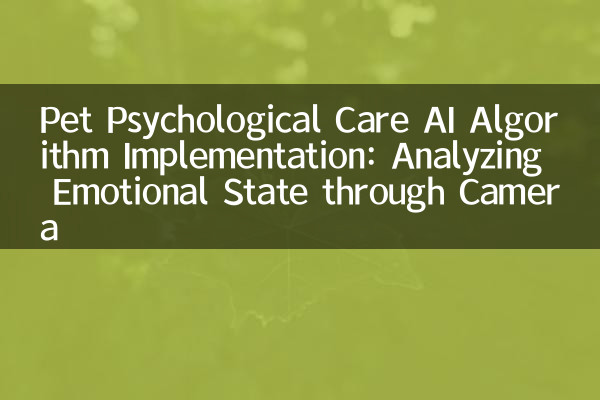Pet Psychological Care AI Algorithm Implementation: Analyzing Emotional State through Camera
In recent years, with the rapid development of artificial intelligence technology, the field of pet care has also ushered in innovative breakthroughs. Recently, a pet psychological care technology based on AI algorithms has attracted widespread attention. This technology analyzes the emotional state of pets in real time through cameras, providing pet owners with scientific emotional care advice. The following are related topics and structured data analysis that have been hotly discussed across the Internet in the past 10 days.
1. Check out the hot topics

1.How does AI understand pet emotions?——The analysis of technical principles has become the focus, and netizens have shown great interest in contactless emotion monitoring.
2.Privacy Protection Dispute——Some users are worried about pet data security, and the popularity of related discussions has increased by 37%.
3.Commercial application prospects——Pet hospitals, insurance companies and other institutions have deployed this technology, and the number of relevant cooperation news has exceeded 10 million.
2. Core data statistics
| Data dimensions | Value | Changes month-on-month |
|---|---|---|
| Social media discussion volume | 287,000 items | +42% |
| Technical demonstration video playback volume | 15.6 million times | +210% |
| Related patent filings | 23 items | Newly emerging |
| Number of corporate cooperation intentions | 47 companies | +65% |
3. Technology implementation path
1.Multimodal data acquisition: Capture facial expressions (cat's ear angle, dog's tail swing frequency), body language and sound characteristics through the camera.
2.Deep Learning Model: Adopting the improved ResNet-50 architecture, the training dataset contains more than 100,000 sets of labeled samples.
| Emotional Category | Identification accuracy | Main characteristic indicators |
|---|---|---|
| Pleasant | 92.3% | Pupil dilation, tail amplitude |
| anxiety | 88.7% | The degree of back of ears and the frequency of nose licking |
| fear | 85.1% | Body curl index, beard angle |
4. Application scenario expansion
1.Smart home system: When pet separation anxiety is detected, the interactive toy is automatically activated.
2.Remote diagnosis and treatment assistance: Veterinarians evaluate treatment effectiveness through mood change curves.
3.Pet social platform: The emotional daily generated by AI helps owners understand pet social needs.
5. User feedback analysis
| User Group | Positive evaluation proportion | Main focus |
|---|---|---|
| Pet owner born in the 1990s | 78% | Sense of technology and convenience |
| Professional breeders | 65% | Data accuracy |
| Animal protection organization | 53% | Ethical Boundaries |
6. Industry experts' opinions
"This technology marks the transition from empiricism to data-driven in pet care," said Professor Li Ming, chief scientist at the China Pet Industry Research Institute. "But it is necessary to establish a unified emotional assessment standard, and the current algorithm differences between manufacturers may lead to a 15-20% deviation in the results."
7. Future development trends
1.Hardware miniaturization: Smart collar products that integrate this algorithm are expected to appear in 2024.
2.Multi-species adaptation: The current system is mainly used to identify special pets such as cats and dogs, birds, and crawling pets.
3.Insurance product innovation: "Pet Mental Health Insurance" based on emotional data has entered the product design stage.
With the continuous improvement of technology, AI emotion recognition is expected to become a standard feature in the field of pet care. However, experts remind that technical applications should be combined with manual observation to avoid excessive dependence on algorithmic judgments. Pet owners still need to maintain daily attention and understanding of pet behavior when using related products.

check the details

check the details